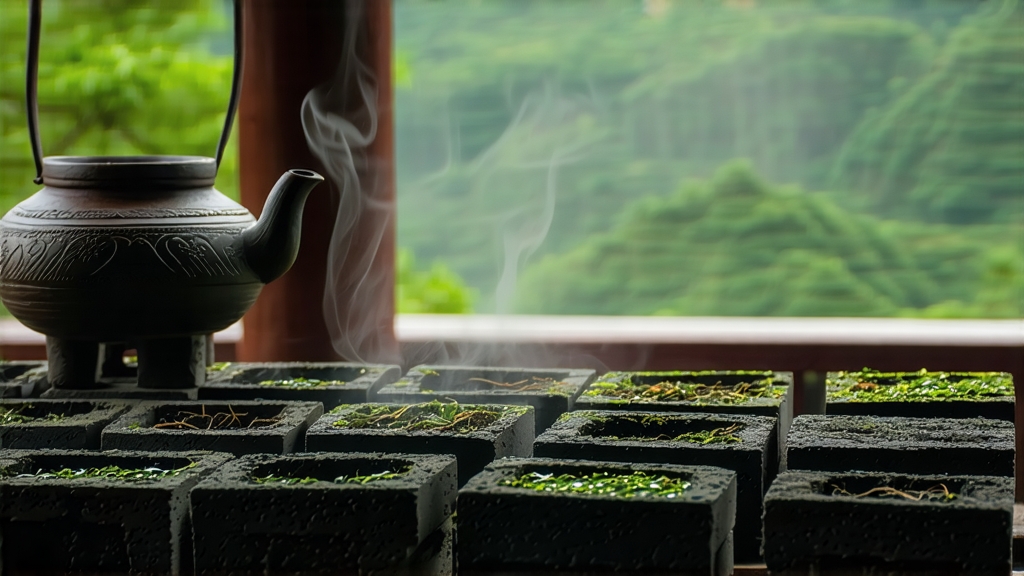
Liu Bao, literally “Six Forts,” is the quiet genius of China’s dark-tea family. While Pu-erh grabs headlines, Liu Bao has spent four centuries polishing its mellow, medicinal character in the humid mountains of southern Guangxi. Foreign drinkers often meet it first as a mystery—leaves the color of midnight, a scent that drifts between wet earth and old library, and a liquor that glows like burgundy held to candlelight. This article invites you to lift the lid on that bamboo-basket mystery, tracing Liu Bao from Ming-dynasty frontier barter to modern gongfu tables, and to learn how to coax its camphor-sweet soul into your own cup.
-
Historical footprints
Tea historians date Liu Bao’s commercial birth to the late 1500s, when merchants from Guangdong and Fujian followed the Xi River into Guangxi. They discovered that the indigenous Daye cultivar, grown around the six ancient fortresses of Cangwu County, survived the long, steamy boat journey down to Hong Kong and eventually Southeast Asia better than green teas. The key was post-fermentation: locals had learned that a few days of “dui wo” (wet piling) in the humid hold of a riverboat softened the leaf’s edges and deepened its flavor. By the Qing dynasty, Liu Bao was listed in the imperial “Tea Tax Register,” and coolies carried it on shoulder poles over the Meiling Pass to Guangzhou’s “Tea Row” warehouses, where European buyers christened it “Chinese Black Tea No. 2,” second only to Pu-erh in export volume. In the 1970s, Malaysian tin-mine owners drank it to ward off rheumatism; today, Kuala Lumpur’s vintage-tea brokers still bid on 30-kilogram bamboo baskets pressed in 1979. -
Terroir and cultivar
Guangxi’s subtropical karst hills trap morning fog, bathing tea gardens in 85 % average humidity. The soil is a well-drained, slightly acidic laterite rich in iron and potassium—minerals that later translate into Liu Bao’s signature metallic finish. Most gardens sit between 200–500 m above sea level, too low for the cloud-cover elegance of high-mountain oolongs, but perfect for the vigorous Daye (Big Leaf) cultivar whose thick cell walls withstand heavy piling. Old-growth trees, some over a century old, are intercropped with cinnamon and longan; their roots share mycorrhizal networks that, according to recent GC-MS studies, contribute trace amounts of cinnamaldehyde and estragole, explaining the tea’s faint sweet-spice note. -
Crafting the darkness
Liu Bao’s processing follows a choreography of heat, moisture, and time that turns chlorophyll into chlorophyllide and catechins into theaflavins, theabrownins, and rare gallic-acid esters.
a. Plucking: One bud plus three or four leaves, ideally after the Grain Rain, when the leaf’s lignin starts to thicken.
b. Wilting: 4–6 hours on bamboo trays in shade; moisture drops to 65 %.
c. Kill-green: A 5-minute tumble in a 200 °C drum halts oxidation but preserves enzymes for later microbial fermentation.
d. Rolling: 40 minutes of light pressure to rupture 30 % of cell walls—enough to release sap without excessive tannin.
e. Wet piling (dui wo): The hallmark step. Leaves are piled 70 cm high, sprayed to 35 % moisture, and covered with jute sacks. Internal temperature climbs to 55 °C within 36 hours; thermophilic bacteria (Bacillus subtilis, Aspergillus niger) bloom, breaking down cellulose and releasing glutamic acid that later sweetens into cocoa tones. The pile is turned every five days; total duration 25–35 days depending on ambient humidity.
f. Drying: Basket-fired over pine-charcoal at 80 °C until 10 % moisture, lending a whisper of smokiness.
g. Aging: Pressed into 30–50 kg bamboo baskets lined with banana leaves, then stacked in humid caves or specially built “tea cellars” where relative humidity hovers at 75 %. Over decades, slow oxidation and microbial secondary metabolism convert remaining catechins into novel pigments like theacitrin, darkening the leaf and smoothing astringency.
- Stylistic spectrum